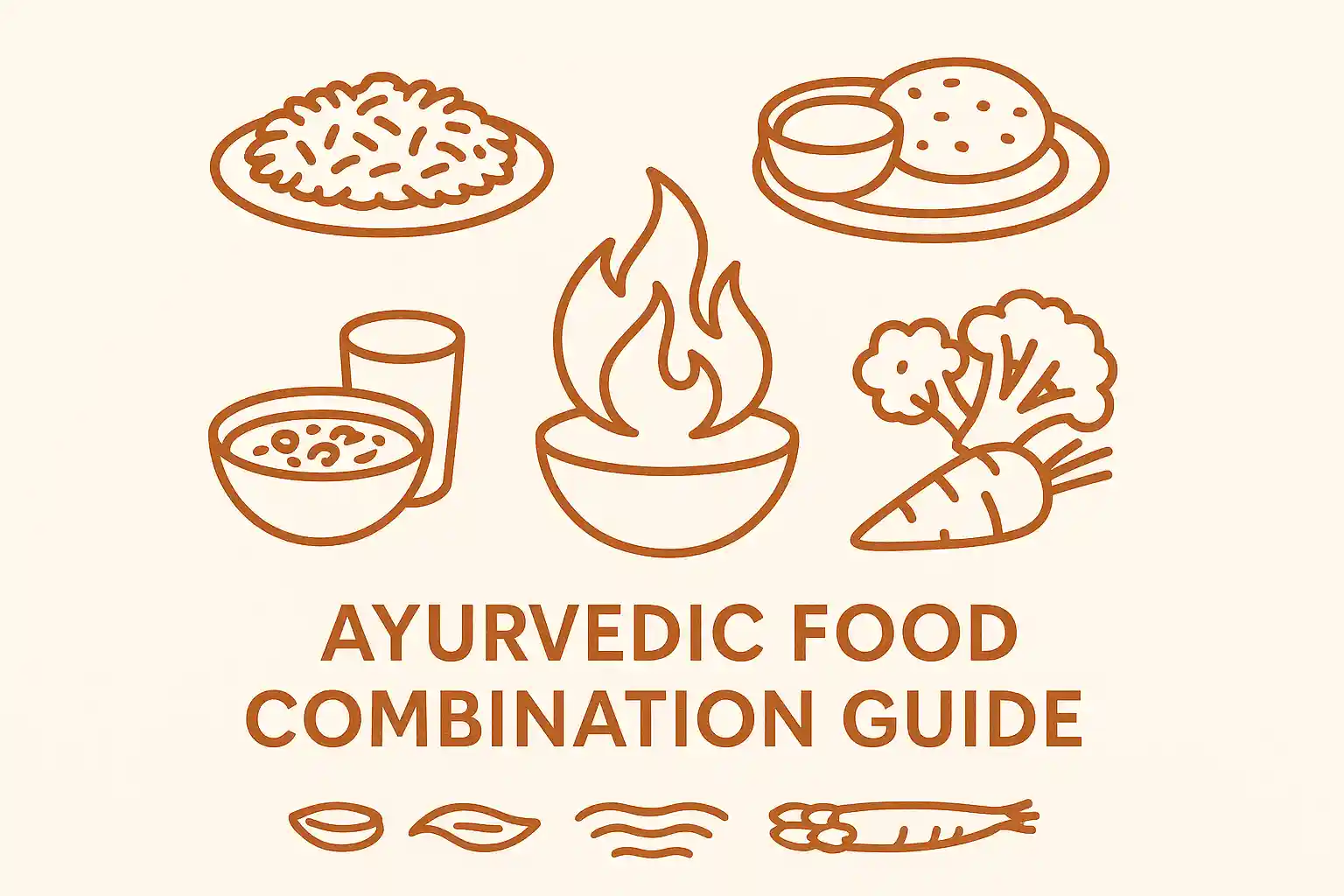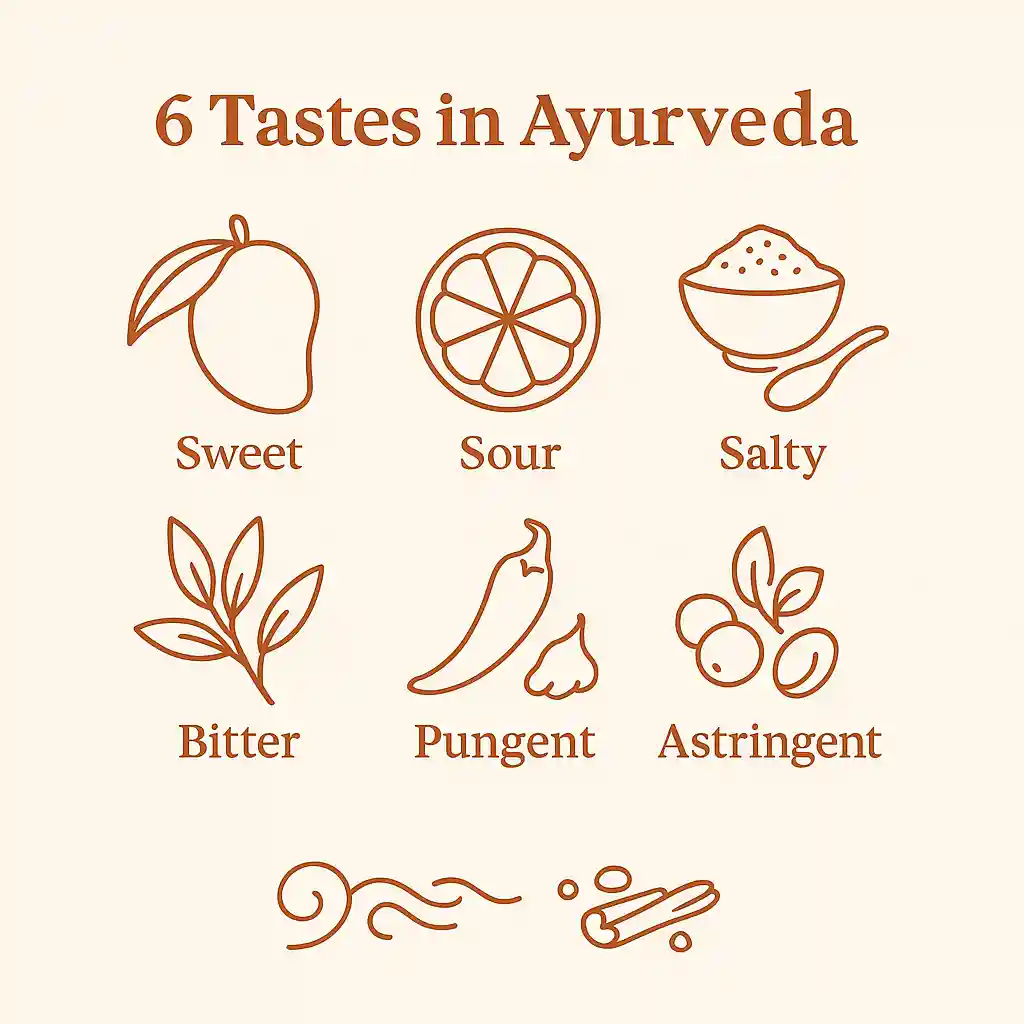In Ayurveda, food is not just fuel—it's a powerful form of medicine. One of the most fundamental principles of Ayurvedic eating is the concept of Rasa, or taste. According to classical texts like the Charaka Samhita, each taste carries unique energetic properties that influence the body, mind, and spirit.
Understanding the six tastes provides a sophisticated framework for creating meals that not only satisfy your palate but actively support your dosha constitution, strengthen digestive fire (Agni), and promote emotional balance.
What Are the 6 Tastes?
Ayurveda recognizes six primary tastes, known as Shadrasa:
Sweet (Madhura)
Elements: Earth + Water
Examples: Milk, grains, sweet fruits, root vegetables
Sour (Amla)
Elements: Earth + Fire
Examples: Citrus fruits, fermented foods, vinegar
Salty (Lavana)
Elements: Water + Fire
Examples: Sea salt, rock salt, seaweed
Pungent (Katu)
Elements: Fire + Air
Examples: Chili, ginger, garlic, mustard
Bitter (Tikta)
Elements: Air + Ether
Examples: Leafy greens, turmeric, bitter melon
Astringent (Kashaya)
Elements: Air + Earth
Examples: Legumes, raw apples, cranberries, green tea
Each taste is composed of two of the Five Great Elements (Pancha Mahabhutas) and has specific effects on the doshas (Vata, Pitta, and Kapha), Agni (digestive fire), and Ojas (vital essence).
The Six Tastes and Their Effects on Doshas
1. Sweet (Madhura) - The Nourisher
Elemental Composition: Earth + Water
Energetic Effects:
- Builds tissues and promotes strength
- Nourishes Ojas (vital essence)
- Provides grounding and satisfaction
- Supports healthy weight gain
Dosha Effects:
- ✓ Pacifies: Vata and Pitta
- ⚠️ Aggravates: Kapha (in excess)
• Whole grains (rice, wheat)
• Sweet fruits (dates, figs)
• Root vegetables
• Dairy products
• Natural sweeteners
2. Sour (Amla) - The Stimulator
Elemental Composition: Earth + Fire
Energetic Effects:
- Stimulates digestion and increases salivation
- Energizing and warming
- Enhances absorption of nutrients
- Promotes mental alertness
Dosha Effects:
- ✓ Pacifies: Vata
- ⚠️ Aggravates: Pitta and Kapha
• Citrus fruits
• Fermented foods
• Yogurt and kefir
• Apple cider vinegar
• Tamarind
3. Salty (Lavana) - The Enhancer
Elemental Composition: Water + Fire
Energetic Effects:
- Enhances flavor of other tastes
- Supports electrolyte balance
- Loosens and softens tissues
- Aids in nutrient assimilation
Dosha Effects:
- ✓ Pacifies: Vata
- ⚠️ Aggravates: Pitta and Kapha
• Himalayan pink salt
• Sea salt
• Rock salt
• Seaweed
• Naturally salty vegetables
4. Pungent (Katu) - The Igniter
Elemental Composition: Fire + Air
Energetic Effects:
- Stimulates digestion and metabolism
- Clears sinuses and respiratory passages
- Promotes circulation and sweating
- Enhances mental clarity
Dosha Effects:
- ✓ Pacifies: Kapha
- ⚠️ Aggravates: Pitta and Vata
• Fresh ginger
• Black pepper
• Chili peppers
• Garlic and onions
• Mustard seeds
5. Bitter (Tikta) - The Detoxifier
Elemental Composition: Air + Ether
Energetic Effects:
- Detoxifying and cleansing
- Clears Ama (toxins) from tissues
- Reduces heat and inflammation
- Promotes mental clarity and focus
Dosha Effects:
- ✓ Pacifies: Pitta and Kapha
- ⚠️ Aggravates: Vata
• Dark leafy greens
• Turmeric
• Bitter melon
• Dandelion greens
• Green tea
6. Astringent (Kashaya) - The Tightener
Elemental Composition: Air + Earth
Energetic Effects:
- Absorbs excess water and moisture
- Tightens and tones tissues
- Anti-inflammatory properties
- Promotes healing and recovery
Dosha Effects:
- ✓ Pacifies: Pitta and Kapha
- ⚠️ Aggravates: Vata
• Legumes and beans
• Unripe fruits
• Raw apples
• Cranberries
• Green tea
Why All Six Tastes Matter
Eating all six tastes at each meal, in appropriate proportions for your dosha, supports:
Physical Benefits
- Balanced Agni (digestive fire)
- Proper tissue nourishment
- Reduced food cravings
- Enhanced nutrient absorption
Mental & Emotional Benefits
- Emotional harmony and stability
- Mental clarity and focus
- Reduced anxiety and restlessness
- Improved mood regulation
From an Ayurvedic perspective, missing or overusing certain tastes can lead to dosha imbalances, poor digestion, or emotional unrest. The six tastes provide a complete sensory and nutritional experience that satisfies both body and mind.
Taste and Dosha Balancing
Tailoring your meals based on your dosha constitution can optimize digestion and wellbeing. Here's how to use the six tastes for dosha balance:
For Vata Dosha
Favor: Sweet, Sour, Salty
Minimize: Bitter, Pungent, Astringent
Vata needs grounding, nourishing tastes that provide stability and warmth.
For Pitta Dosha
Favor: Sweet, Bitter, Astringent
Minimize: Sour, Salty, Pungent
Pitta benefits from cooling, calming tastes that reduce heat and inflammation.
For Kapha Dosha
Favor: Pungent, Bitter, Astringent
Minimize: Sweet, Sour, Salty
Kapha requires stimulating, lightening tastes that promote movement and metabolism.
The Emotional Influence of Taste
Ayurveda recognizes that taste affects not only the body but also the mind and emotions. Understanding these connections can help you use food as medicine for emotional balance:
| Taste | Emotional Quality | Mental Effect |
|---|---|---|
| Sweet | Contentment, love, satisfaction | Calming, nourishing to the mind |
| Sour | Sharpness, competitiveness | Stimulating, enhances focus |
| Salty | Satisfaction, grounding | Stabilizing, promotes confidence |
| Pungent | Clarity, passion, intensity | Energizing, promotes alertness |
| Bitter | Detachment, mental clarity | Clears mental fog, promotes insight |
| Astringent | Introspection, self-reflection | Contemplative, promotes focus |
Practical Tips for Using the 6 Tastes
Daily Practice
- Include small amounts of all six tastes at lunch (your main meal)
- Start meals with something sweet or salty to stimulate Agni
- End with bitter or astringent to aid digestion
- Use spices and herbs to easily incorporate missing tastes
Seasonal Adjustments
- Emphasize warming tastes (sweet, sour, salty) in cold seasons
- Focus on cooling tastes (sweet, bitter, astringent) in hot weather
- Use pungent taste to counter excess Kapha in spring
- Increase sweet taste during times of stress or depletion
Simple Ways to Include All Six Tastes
Traditional Indian Thali Approach:
- Sweet: Rice, chapati, or sweet vegetable
- Sour: Pickled vegetables or yogurt
- Salty: Properly salted main dishes
- Pungent: Fresh ginger or spiced preparations
- Bitter: Leafy greens or turmeric in cooking
- Astringent: Lentils/beans and herbal tea after meals
Spice Combinations for Balance
Use these spice blends to easily incorporate multiple tastes:
- For Vata: Cumin, coriander, fennel, ginger (warming and grounding)
- For Pitta: Coriander, fennel, cardamom, mint (cooling and soothing)
- For Kapha: Black pepper, mustard seeds, turmeric, cayenne (stimulating and heating)
Listening to Your Body's Wisdom
Pay attention to your natural cravings—they often indicate which tastes your body needs for balance:
Common Craving Patterns:
- Sweet cravings: May indicate Vata imbalance or need for grounding
- Salty cravings: Often signals dehydration or Vata excess
- Sour cravings: May indicate need for digestive stimulation
Aversion Patterns:
- Avoiding bitter: May indicate Vata imbalance
- Avoiding pungent: Often signals Pitta excess
- Avoiding astringent: May indicate digestive weakness
Seasonal Considerations for Taste
Align your taste preferences with seasonal rhythms for optimal health:
Frequently Asked Questions
Conclusion: Creating Harmony Through Taste
The six tastes in Ayurveda offer a simple yet profound way to align your meals with your body's needs. By consciously incorporating all six tastes in appropriate proportions for your dosha, you not only satisfy your palate but also support your overall health, digestion, and emotional well-being.
Remember that developing sensitivity to taste and its effects takes time and practice. Start by simply noticing which tastes you gravitate toward and which you avoid, then gradually work to include a broader spectrum of tastes in your daily meals.
The ancient wisdom of Rasa reminds us that eating is not just about nutrition—it's about creating harmony between our inner constitution and the natural world around us.
Related Articles

What Is Agni? A Beginner's Guide to Ayurvedic Digestive Fire
Discover Agni, the vital digestive fire in Ayurveda that transforms food into energy and health. Learn the 4 types of Agni, signs of imbalance, and practical ways to strengthen your digestive fire naturally.
12 min read
Why Food Combining Matters in Ayurveda: A Guide to Better Digestion
Discover the ancient wisdom of food combining in Ayurveda. Learn which food pairings to avoid and how proper combining can strengthen your digestive fire (agni) for optimal health.
7 min read
